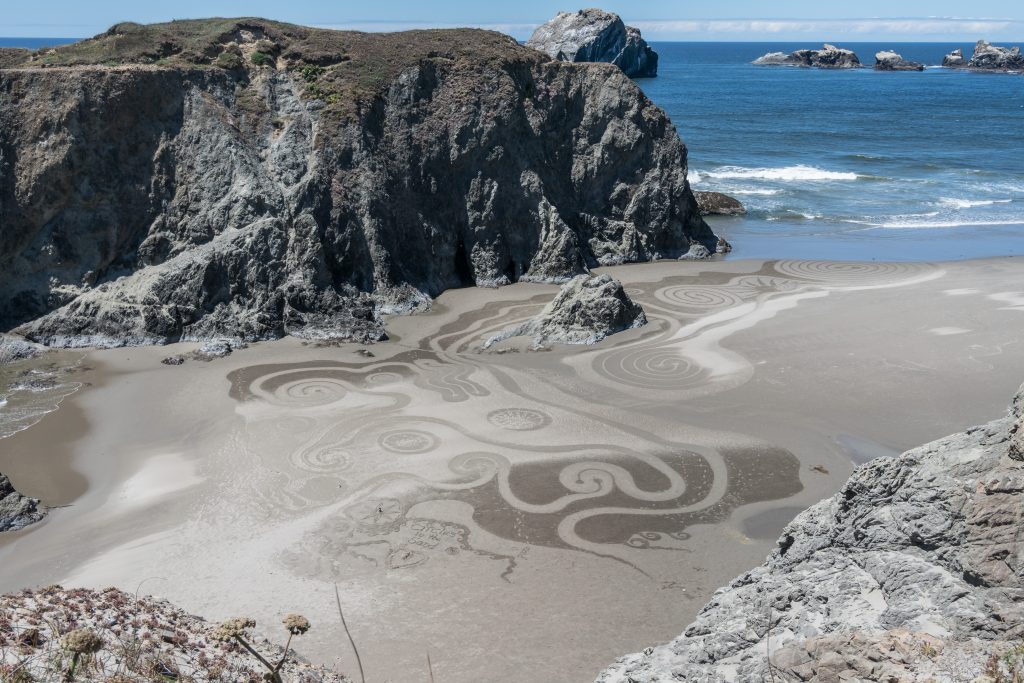Artist draws labyrinths in the sands of Oregon beaches

The beach can be a place to relax. The ocean waves and salt air can have a calming effect. In Southern Oregon, some visitors can also find labyrinths that have been drawn in the sand.
A labyrinth is a very old idea. According to Cambridge Learner’s Dictionary, a labyrinth is “a confusing set of connecting passages or paths in which it is easy to get lost.” In other words, a traditional labyrinth is like a maze.
However, not all labyrinths are difficult puzzles. Some are used for meditation. People can walk along its twisting and turning path. Labyrinths for meditation have no wrong turns or dead ends. There is only one way to the center, and there is only one way out.
Denny Dyke is an artist. He creates labyrinths in the sand. “The point of the labyrinth is to enjoy the journey,” he says. “All you have to do is follow the path and you will get there.”
Denny creates his labyrinths on the beaches near Bandon. He uses rakes and spears. The walk takes about 20 minutes. However, the labyrinths are not permanent. They last only a few hours. Then the ocean tide washes them away.
For a schedule, pictures, and more information, go to: https://www.sandypathbandon.com/
-This story was first published in ESOL News Oregon August 1, 2020.
Check
Discuss
- Look up the pronunciation of “labyrinth” in an online English-English dictionary such as Longman. It’s an unusual word. How many syllables does this word have? (Hint: There is more than one correct answer.) Where is the stress? Practice with your classmates.
- Look at the Longman dictionary again to find the adjective form of “labyrinth.” How could you use this word in a sentence? Practice with your classmates.
- A labyrinth is a kind of a maze. Have you ever completed a maze on paper or walked through a maze made out of plants? Tell your classmates about your experience.
- Sand is a great material for being creative because you can form it into different shapes, such as the labyrinths that Dyke creates on the beach. Many people like to build sand castles when they go to the beach. What about you? Have you ever built a sand castle? Do you have any pictures to show your classmates? If you don’t have any personal experience with sand castles, search online for interesting sand creations and share with your classmates. What is your favorite?
Write
- The art that Dyke creates is not permanent. It only lasts for a short time. Why do you think he still takes the time to create it? Think of other things in life that last for a short time and yet are important and meaningful. Use these examples to help you understand and explain Dyke’s labyrinths.
- Sand mandalas are similar to labyrinths in the sand. They are beautiful, and they have intricate designs. Sand mandalas are created by Buddhist monks who destroy them after they complete them. Why do you think they do this? Compare and contrast Dyke’s labyrinths and the monks’ mandalas.
- How can doing something repetitive like walking in a circle in a labyrinth be good for you? How can this activity help your mind slow down? Can you tolerate repetition like this, or do you find it boring? Why?
- “The point of the labyrinth is to enjoy the journey,” artist Dyke says. “All you have to do is follow the path and you will get there.” Can you interpret his words as a metaphor for life? Explain. What is the journey? What is the path? Where are you trying to get to?
Sources
“Circles in the Sand.” Circles 2020, 2020, www.sandypathbandon.com/. Accessed 31 July 2020.
Path, Sandy. “Drawing ~ Circles in the Sand.” Www.youtube.com, 29 July 2017, www.youtube.com/watch?v=nTbMBuQ-DD4.
“The Spiritual and Mental Health Benefits of Walking a Labyrinth.” Verywell Fit, www.verywellfit.com/walking-the-labyrinth-3435825. Accessed 31 July 2020.
Wallace, Kelsey. “The Sand Labyrinths Of Bandon, Oregon.” Opb, 30 June 2017, www.opb.org/artsandlife/series/summer-series/bandon-oregon-beach-sand-labyrinths-things-to-do/. Accessed 31 July 2020.

